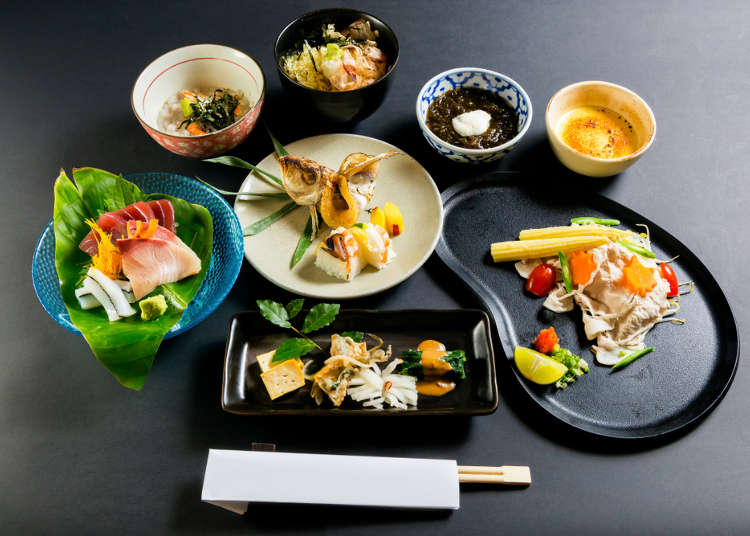
Manners & More: What Exactly Is Japan's 'Kaiseki Cuisine' - And How To Order?
- Written by: WESTPLAN
'Kaiseki' is one of the more intricate forms of Japanese cuisine you might come across. As soon as they learn of it, many people may even like to try authentic Japanese cuisine kaiseki when they visit Japan. However, some people may be hesitant to give it a go because they think the etiquette involved may be complicated.
This article, supervised by Food Journalist Kazuhiro Soga (of Creators Factory Ltd.), will detail what kind of food kaiseki is, what order it is served on the menu, and any rules for eating it.
1. What Exactly is Kaiseki Ryori?
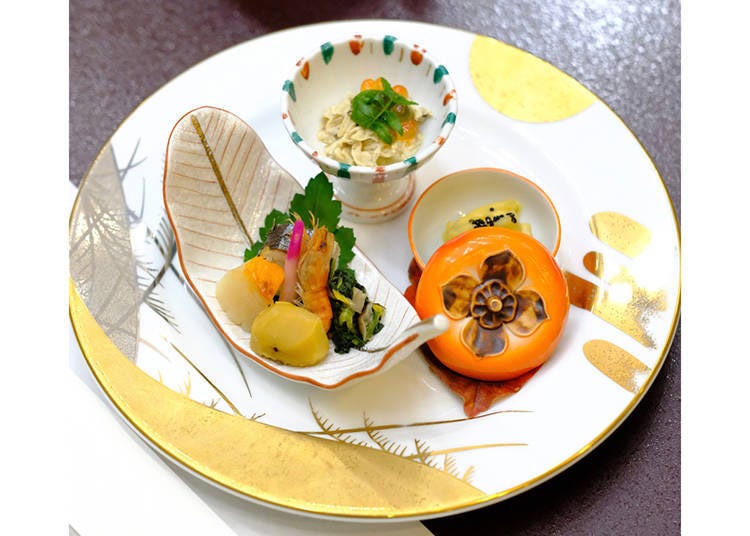
Kaiseki Ryori (懐石料理) is a type of cuisine that was served at tea ceremonies (cha-kaiseki), and after the kaiseki meal, a tea called koicha was served.
There is some detailed etiquette involved, but the main premise is the host "entertaining" guests.
To express the tea ceremony philosophy of "wabi sabi" (a world view centered on the acceptance of transience and imperfection), dishes are prepared based on the three themes of using seasonal ingredients, bringing out the flavor of the ingredients to the fullest, and entertaining guests. The basic concept is "one soup, three dishes" - rice, soup, three side dishes, and pickles.
The word "kaiseki" by itself refers to all kinds of food, but to distinguish it from the cha-kaiseki served in tea ceremonies, the food served in Japanese restaurants is called "kaiseki ryori." The ones from restaurants are sometimes arranged a little differently and include western-style items or more items.
2. Know the Origin and History of Kaiseki Cuisine
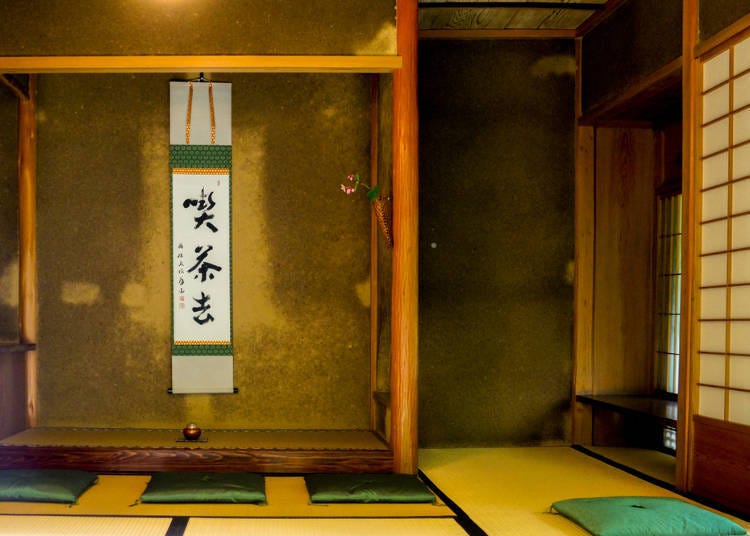
Kaiseki has a deep connection with Zen Buddhism. Zen Buddhist monks had only one meal a day. When they got hungry, and their body temperature dropped, they would place a warm stone on their stomach to warm themselves up and at the same time stave off hunger. That stone is called "Onjaku."
The kanji character for "kaiseki" is stone and stomach. In the tea ceremony, a simple meal before the tea ceremony is called "Kaiseki," meaning a light meal that warms the body and eases hunger, like a warm stone to your stomach.
Originally, kaiseki was not a luxurious meal to be eaten with sake, but rather a dish to fill one's stomach to enhance the tea experience further.
3. What is the Difference between the Two Kaiseki Ryori?
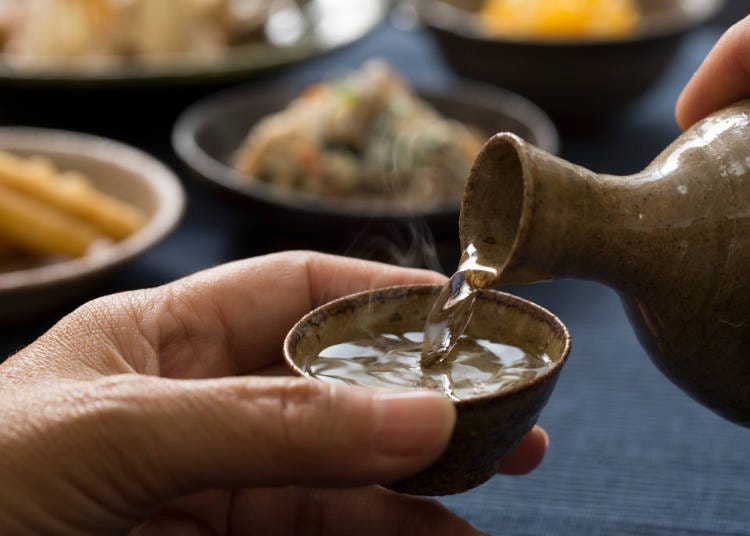
There are two types of kaiseki cuisine, one using the characters "懐石" and other using "会席." Both are read as kaiseki.
"会席" is based on honzen ryori, which was prepared by samurai to entertain their guests. Honzen ryori has a significant ceremonial element, so in modern times it is only used for weddings and funerals.
The distinction between the two kaiseki cuisines is that one is meant to be enjoyed with sake. In modern Japan, Japanese full-course meals are mainly "会席" and use both honzen and "懐石" elements.
4. Kaiseki Cuisine Menu and Kaiseki Etiquette
As explained earlier, the basic kaiseki for tea ceremonies is one soup and three dishes.
Still, many Japanese restaurants, where you will most likely experience it, have their own arrangements, such as increasing the number of dishes or changing the order.
The flow of the course may vary from restaurant to restaurant, but here is an example of the order.
Remember that the goal of a kaiseki dinner is to enjoy eating good food with others. There is no need to think too hard about it, but it is good to know the etiquette and arrange it according to the atmosphere of the occasion.
Let's also learn the proper etiquette with the flow of the course.
a. Sakizuke (先付)
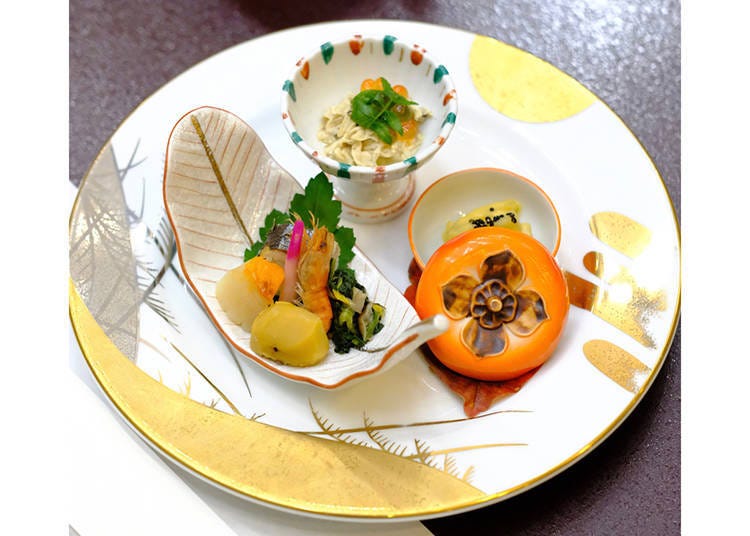
It is the first thing to eat after sipping sake. Many dishes are refreshing, such as vegetable dishes or namasu (vinegared fish and vegetables cut into thin strips). The dishes are placed on "oshiki," which are flat plates that are like trays. Many small portion dishes are served on it. Each one is seasoned and can be eaten as it is.
b. Nimonowan (煮物椀)
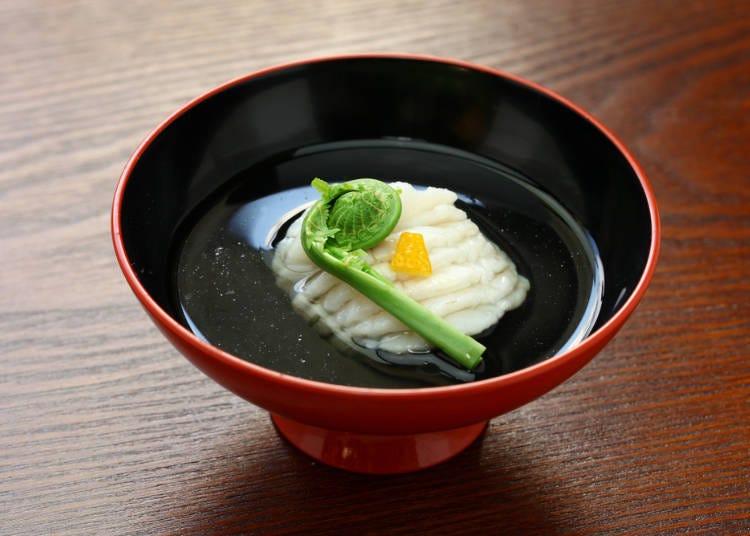
Nimonowan is served in a bowl with a lid, hold the bowl down with your left hand and remove the lid with your right hand. Sumashi soup (lightly seasoned soup stock made from kelp and bonito) with seasonal fish, vegetables, or chicken is served in the bowl.
The broth's flavor is the key to making this soup, and this is where the chef's skill comes into play.
First, sip the soup, and then eat the ingredients. The gentle flavor of the stew will ease your mind. Make sure to finish all the soup.
c. Tsukuri (造り)
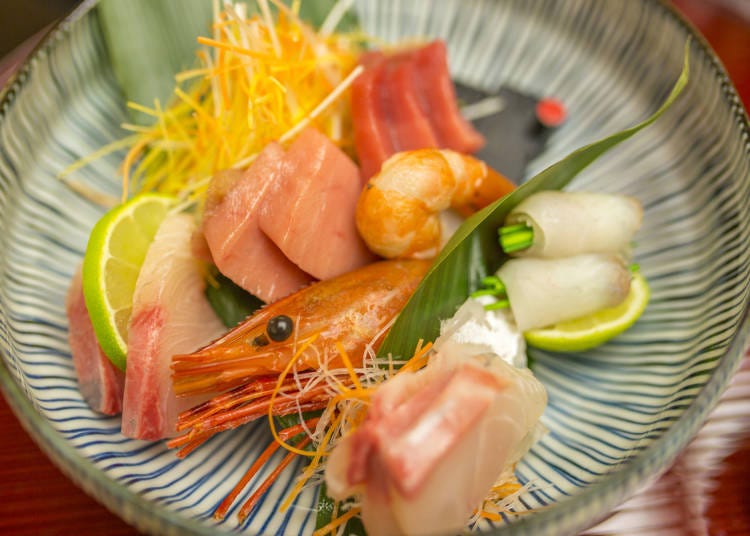
Tsukuri is sashimi prepared with special techniques to enhance the dish.
"Kombujime" is a method where the fish is sandwiched between two pieces of kelp, which helps transfer flavor and umami to it (kelp is not eaten), and "kakushi bocho" is a method of lightly scoring the fish in places it can't be seen, so it is easier to eat.
With the lighter dishes in the front, you eat from front to back.
d. Yakimono (焼物)

The main dish of Kaiseki cuisine, grilled fish, is often made from seasonal white fish. But recently, wagyu beef, shellfish such as abalone, and crustaceans such as lobster are sometimes served. Fillets are easy to eat, but many first-timers may have difficulty eating a fish clean when the tail and head are still attached.
The fish is served with the head to the left and the tail to the right. The first thing to do is eat the meat above the fish's backbone from the head to the tail.
Next, hold the head of the fish with your left hand, insert your chopsticks between the bone and meat on the bottom, remove the bone, place the head and bone together at the back of the plate, and then eat the remaining part of the fish.
Wipe your hands and fingers after touching the fish with the napkins on the table.
e. Hashiyasume (箸休め)
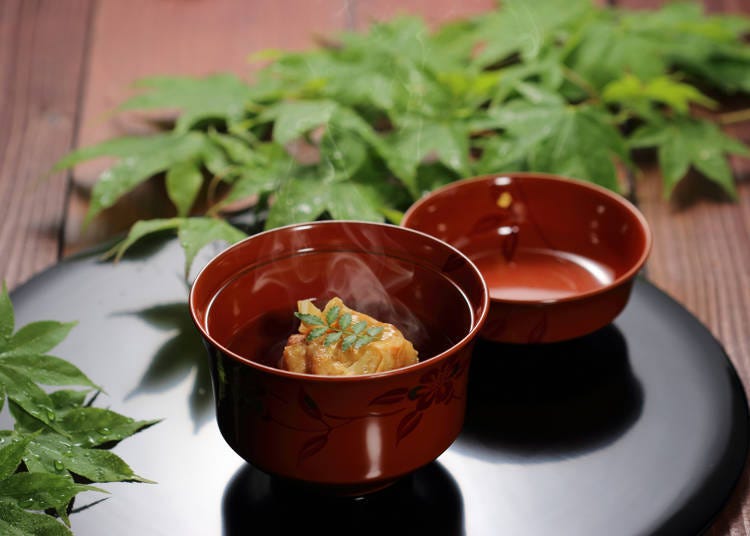
This soup is also called "hashi arai,"(chopstick cleaner) and is served in a small bowl. Drink all the soup, as it is meant to wash away the taste of the food left in your mouth and prepare for the next dish.
f. Hassun (八寸)
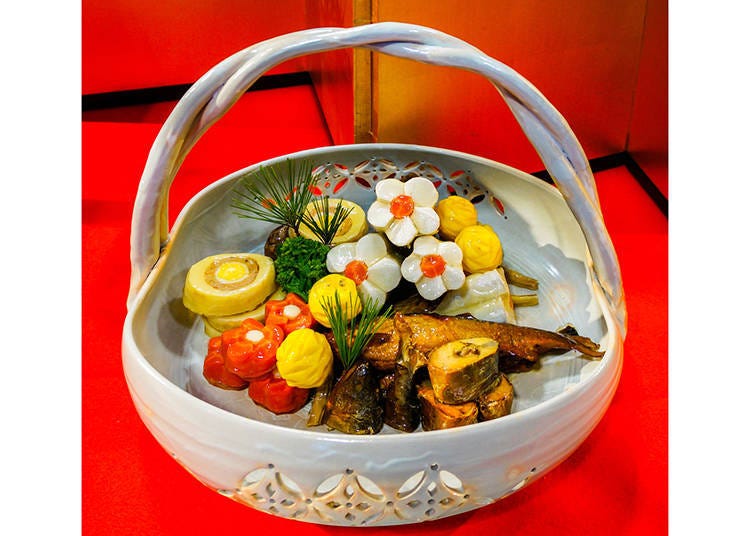
Typically, few delicacies from the mountain and sea that go with sake are served on a 20cm square tray, but recently round trays have also been used.
Branches and leaves are used as food dividers and are not edible. If you are not sure what is edible, please ask the staff, as it is not rude. While eating the colorful and visually appealing dishes on the plates, get to know your companions better with a drink.
g. Takiawase (炊き合わせ)
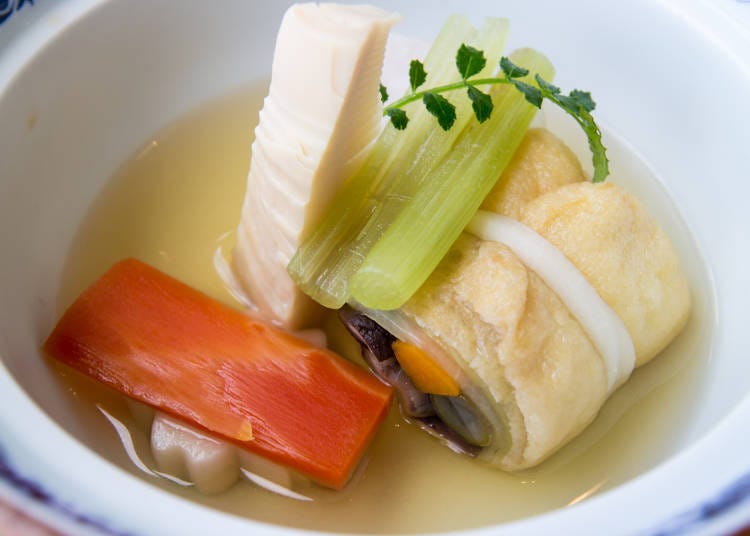
Takiawase is vegetables cooked separately in light flavors. It is often served in a bowl with a lid, so remove the lid and admire the beautifully cut vegetables before eating it.
In this case, the superior opens his or her lid first, and then you open yours. To do this, support the bowl with your left hand and slowly turn the lid with your right hand to open it, let any condensation on the inside of the lid drip into the bowl, hold the lid with both hands, turn it over and place it on the desk. When you have finished eating, replace the lid just as it was served.
h. Gohan and Komono (ご飯と香の物)
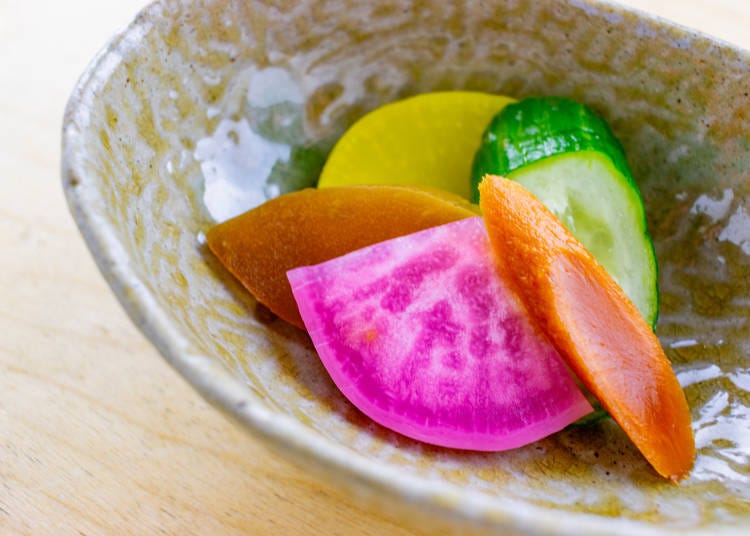
Freshly cooked white rice or rice cooked with ingredients, red miso soup, and three to five kinds of pickles are served on small plates. Pickles signal the end of the meal. This is where the food ends.
i. Kashi and Matcha (菓子・抹茶)

The after-dinner dessert is mostly wagashi (Japanese sweets), but sometimes fruits or sorbets are served. Many of them have a clean flavor to refresh the palate.
The fruit is cut into pieces so that it is easy to eat and is eaten from the right side.
If wagashi and matcha are served, eat the wagashi first, then the matcha. Japanese sweets sometimes come with a small stick called a kuromoji. Use the kuromoji to cut the wagashi into small bite-sized pieces and bring them to your mouth.
The manner of drinking matcha is not so important in a restaurant, but you should lift the bowl with both hands and drink a little at a time. It is said that it is best to drink only the last sip at once.
Kaiseki cuisine has multiple dishes, but since it is essentially a light meal to be eaten before tea, each dish is small in quantity. When you finish one dish, you are immediately served the next one, which shows the spirit of service of the restaurant.
The flow and content of kaiseki cuisine introduced here are just a few examples. Depending on the restaurant, fried or steamed dishes may be served, and the order and content may vary. However, if you know the basics introduced here, you should be able to predict and handle other variants.
5. Etiquette in Kaiseki Restaurants
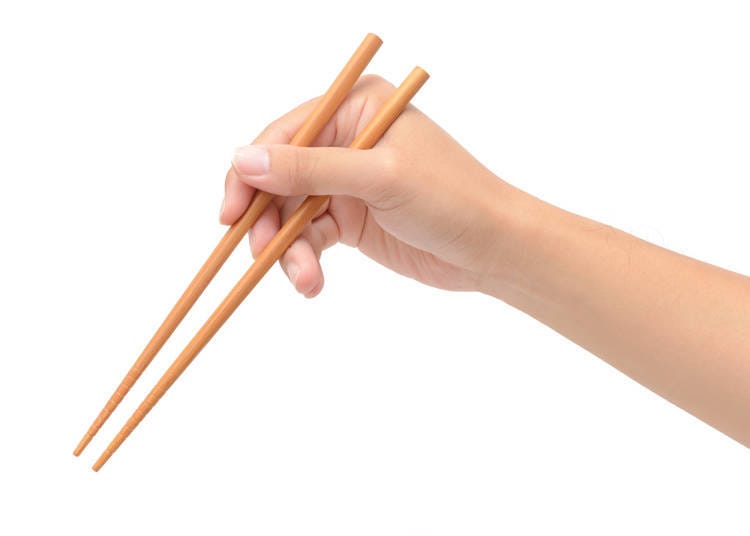
Kaiseki cuisine eaten at a restaurant does not require you to know the detailed etiquette like eating at a tea ceremony, but you should know the basic manners.
If you know in advance that you will be in a Japanese-style room, you should wear socks or stockings instead of going barefoot. (Be sure your socks haven't any holes in them, too!)
Be careful not to wear strong perfume, as it will interfere with the aroma of the meal.
Also, some soup bowls are lacquered with urushi, and many matcha bowls are expensive, so considering that you will be directly touching them, it is better to remove rings and other finger jewelry to avoid damaging the bowl.
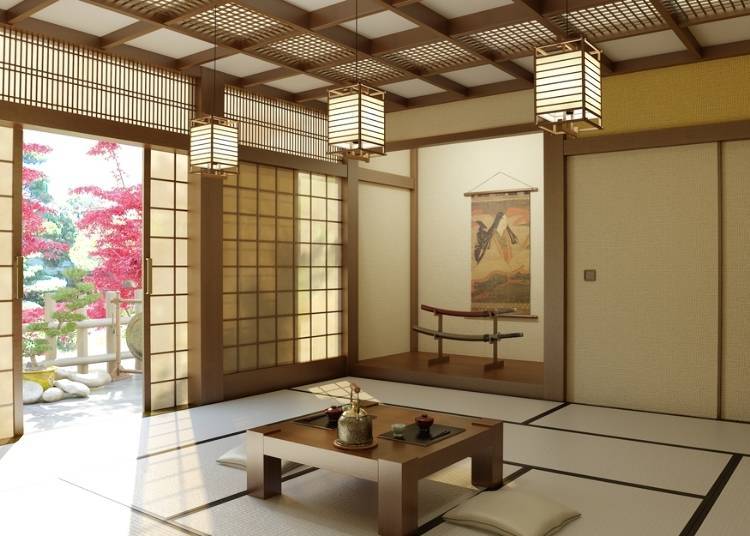
These days, many restaurants offer table seating, but if you are dining in a Japanese-style room, there is old etiquette for entering the room.
First of all, do not step on the edge of the tatami mat (the part of the fabric with the pattern on it) or the shikii (the wooden part that divides the room underneath the shoji or fusuma).
The seat closest to the tokonoma (a raised area with hanging scrolls on the wall and flowers and ornaments on the floor) is Kamiza (upper seat), and the seat closer to the doorway is Shimoza (lower seat).
If you are with superiors, casually suggest that they sit in the upper seat and you sit in the lower seat. When moving around the room, do not step over or step on the cushion while standing. When sitting, kneel down and gently sit down from the side of the cushion.

The basic rule is to use your right hand for chopsticks and your left hand for the bowl, but this does not apply to left-handed people.
Lift the bowl with your left hand to eat. As a rule of thumb, if the bowl is smaller than the palm of your hand, you should lift it; if it is larger, you should leave it.
In other words, teacups, soup bowls, small bowls, small plates, and rice bowls are allowed to be lifted, while flatware made of pottery, tempura plates, and large bowls are not.
If you don't want to lift the bowl, you can either transfer the dish to a plate before lifting it, or use a napkin as an ukezara (a plate that is used to prevent dripping of food). Try not to use your left hand as an ukezara.
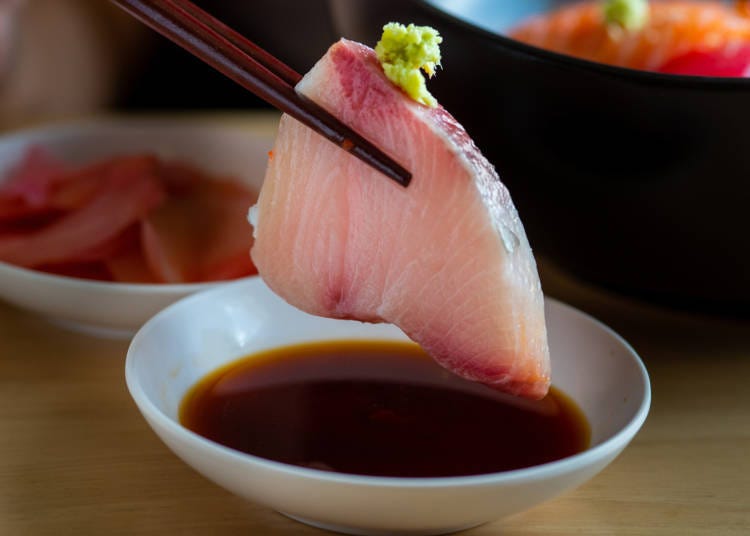
Also, when eating sashimi, do not mix the wasabi in the soy sauce, but take a small amount of wasabi with your chopsticks, place it directly on the fish, and then dip it in soy sauce in a small dish.
Don't eat all the rice, soup, or pickles at once; take bites in order.
If you don't know how to eat a certain dish or if you want to know what the ingredients are, it is not rude to ask the waiter. The more knowledge you have, you will become more interested in the cuisine.
Enjoy Kaiseki Cuisine - Itadakimasu!
Kaiseki cuisine, a traditional Japanese cuisine, is now popular as a course meal where you can taste many dishes in small portions. The content varies from restaurant to restaurant, as some have a course meal called European Kaiseki. Feel free to visit restaurants to see what kind of dishes will be served in what order.
Supervised by Kazuhiro Soga, Food Journalist (Representative of Creators Factory Ltd.)
Kiko Matsuda, Keiko Kimura, Risa Tsushi, and a team of female writers familiar with Kansai. We love eating, drinking and traveling! We share fun information based on our experiences.
*Prices and options mentioned are subject to change.
*Unless stated otherwise, all prices include tax.
Popular Tours & Activitiess
Recommended places for you
-

MINOKICHIHoteruhankyuintanashonaru
Japanese cuisine
Umeda, Osaka Station, Kitashinchi
-

Sushi Tamahime KYOTO
Japanese cuisine
Kyoto Station, To-ji Temple
-

KitazuienUmeda
Japanese cuisine
Umeda, Osaka Station, Kitashinchi
-

Hachiko
Japanese cuisine
Umeda, Osaka Station, Kitashinchi
-

Ichii
Japanese cuisine
Namba, Dotonbori, Shinsaibashi
-

Asai
Japanese cuisine
Namba, Dotonbori, Shinsaibashi
-
Ad

Experiencing Manga as Culture, Not Just Reading It: Expo 2025 with Rumiko Takahashi
-
Ad

Discover Timeless Beauty: Kimono-en, a Web Magazine Exploring the Spirit of Kimono
-

Curious About Sake? I Visited a Sake Brewery in Japan and Here's What I Learned
-

Everything You Need to Know About teamLab Biovortex Kyoto (2025 Insider Guide)
by: Wemmy Chau
-
Ad

Recharge and Relax with a Healing Getaway at Kamenoi Hotel Toba
-

Best Things to Do and See Around Kyoto & Osaka in September: Events and Festivals in Kansai
Inspiration for Accommodations
-

Spacious Family Hotel in Namba: 20 Comfortable Stays for Family Fun
-

Charming Hotels to Enjoy the Spectacular Views of Arashiyama's Autumn Leaves from Your Room
-

Experience Stunning Views of Osaka Castle from Private Spaces: Top Hotels Near Osaka Castle
-

Recommended by Visitors! Arashiyama's Best-Rated Hotels
-

Family-Friendly Universal Studios Japan Hotel with Excellent Access
-

Enjoy a Comfortable Stay in Osaka! 10 Hotels with Convenient Airport Shuttle Services
-

Top 10 Recommended Hotels Near Namba Station with Great Access
-

Enjoy Night Views from Your Room! Recommended Hotels in Namba Area
-

Visit These 2 Restaurants in Kyoto To Enjoy Gorgeous Autumn Colors While Dining
-

Sightseeing Highlights: Experience the Appeal of Kyoto Geisha Culture
-

JR Edition: Visit all of Tokyo in one Day with the Tokyo Metropolitan District Pass!
-

Dining in Arashiyama: 18 Must-Try Restaurants for Scenic Kyoto Cuisine
by: Wong Man Yee
-

Japan's Bath Culture: Tips You Should Know!
-

What to Eat in Kyoto: 3 Awesome Obanzai Restaurants Near Kyoto Station!
- #best gourmet Osaka
- #things to do Osaka
- #what to do in kyoto
- #what to bring to japan
- #best gourmet Kyoto
- #new years in Osaka
- #what to buy in nanba
- #Visiting Osaka
- #onsen tattoo friendly arima
- #daiso
- #Visiting Kyoto
- #best japanese soft drinks
- #japanese fashion culture
- #japanese convenience store snacks
- #japanese nail trends













